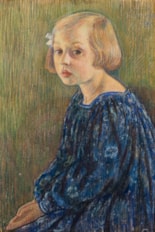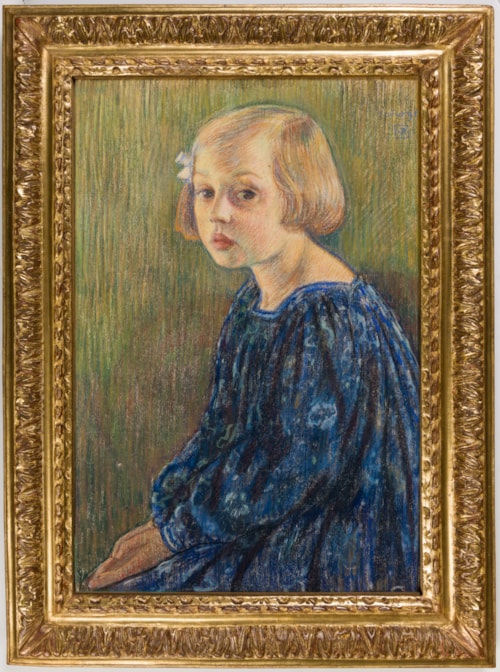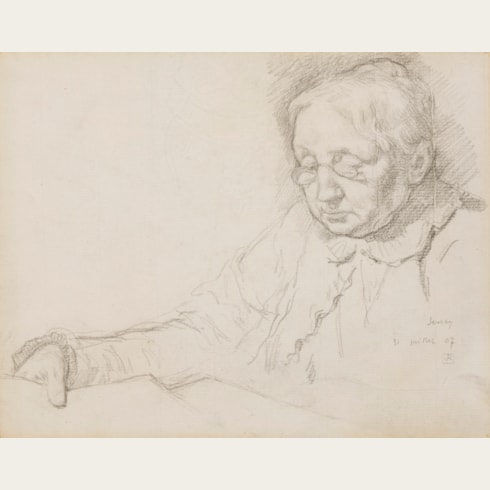Théo van RYSSELBERGHE
(Ghent 1862 - Saint-Clair 1926)
Portrait of the Artist’s Daughter, Élisabeth Van Rysselberghe
Sold
Pastel.
Signed with the artist’s monogram and dated 7 août 96 VR in blue chalk at the upper right.
563 x 380 mm. (22 1/8 x 15 in.)
Signed with the artist’s monogram and dated 7 août 96 VR in blue chalk at the upper right.
563 x 380 mm. (22 1/8 x 15 in.)
This splendid pastel is a portrait of the artist’s only child, Élisabeth Van Rysselberghe (1890-1980), who is depicted here at the age of five. The artist made several portraits of Élisabeth, whose godfather was the Belgian writer and art critic Emile Verhaeren, from her childhood to young adulthood. (This pastel portrait was, in fact, first illustrated in an article by Verhaeren devoted to Van Rysselberghe, published in the November 1899 issue of Ver Sacrum, the official periodical of the Vienna Secession.) A similar painted portrait of her at about the same age and with the same bow in her short hair, is in a private collection. Sylvia Beach, the American-born bookseller and publisher who owned the Parisian bookshop Shakespeare and Company, once described Élisabeth as ‘a handsome, rather boyish girl’3, and she always seems to have kept her hair fairly short. In 1911 the young Élisabeth Van Rysselberghe had a brief but intense affair with the English poet Rupert Brooke, with whom she maintained a correspondence until his death from septicaemia in 1915, which left her devastated.
A few years after this portrait was drawn, when Élisabeth Van Rysselberghe was nine years old, her parents met the writer André Gide, who was to become close to both Théo and his wife Maria. Gide and Théo exchanged countless letters over many years, while the artist’s wife Maria kept a journal-cum-diary of Gide’s life, unbeknownst to him, for over thirty years. Their daughter Élisabeth was to have an affair with Gide, who was twenty-one years her senior, and had a daughter by him in 1923. As her mother Maria Van Rysselberghe noted of Élisabeth, ‘She was as if subjugated by Gide, attracted by a force to which, no doubt, she gave no name and which would later flourish.’ Élisabeth raised their child on her own, causing something of a scandal at the time, since she also refused to divulge the identity of the girl’s father, even to close relatives. Although Gide was devoted to both Élisabeth and his daughter, he too kept his paternity a secret from almost everyone he knew. Élisabeth eventually married the writer Pierre Herbart, Gide’s secretary, in 1931.
The present sheet remained in the sitter’s family for over a century, until 2006. After Elisabeth’s death in 1980 it passed to her illegitimate daughter with André Gide, Catherine Elisabeth Van Rysselberghe Gide (1923-2013), who had only discovered the identity of her true father when she was thirteen years old.
A few years after this portrait was drawn, when Élisabeth Van Rysselberghe was nine years old, her parents met the writer André Gide, who was to become close to both Théo and his wife Maria. Gide and Théo exchanged countless letters over many years, while the artist’s wife Maria kept a journal-cum-diary of Gide’s life, unbeknownst to him, for over thirty years. Their daughter Élisabeth was to have an affair with Gide, who was twenty-one years her senior, and had a daughter by him in 1923. As her mother Maria Van Rysselberghe noted of Élisabeth, ‘She was as if subjugated by Gide, attracted by a force to which, no doubt, she gave no name and which would later flourish.’ Élisabeth raised their child on her own, causing something of a scandal at the time, since she also refused to divulge the identity of the girl’s father, even to close relatives. Although Gide was devoted to both Élisabeth and his daughter, he too kept his paternity a secret from almost everyone he knew. Élisabeth eventually married the writer Pierre Herbart, Gide’s secretary, in 1931.
The present sheet remained in the sitter’s family for over a century, until 2006. After Elisabeth’s death in 1980 it passed to her illegitimate daughter with André Gide, Catherine Elisabeth Van Rysselberghe Gide (1923-2013), who had only discovered the identity of her true father when she was thirteen years old.
A gifted painter and draughtsman, Theo van Rysselberghe studied at the Academy in his native Ghent and first exhibited his work in 1880 before completing his artistic training in Brussels, at the Académie Royale des Beaux-Arts, where he studied with Jean-François Portaels. He was a member of the Belgian artist’s society L’Essor and in 1883 was among the founder members of the more avant-garde group Les XX, who rejected academism and rebelled against the artistic standards of their time. It was through this artistic circle that Van Rysselberghe met such influential artists, including James Ensor, Fernand Khnopff and James McNeill Whistler.
A pivotal moment in Van Rysselberghe’s development as an artist came in 1886, at the eighth impressionist exhibition in Paris, where he encountered Georges Seurat’s monumental pointillist canvas A Sunday Afternoon on the Island of La Grande Jatte, painted between 1884 and 1886. This led Van Rysselberghe to experiment with the pointillist technique; and from 1886 onwards he was working in a Neo-Impressionist manner, becoming one of the leading exponents of pointillism in Belgium. In 1897 Van Rysselberghe left Brussels for Paris, where he worked on the anarchist journal Le Temps nouveaux, alongside other artists including Paul Signac, Maximilien Luce, Camille Pissarro and Kees Van Dongen. Regarded as the finest portrait painter among the Neo-Impressionists, he continued working in a pointillist manner until around 1907. Among his most significant later commissions was for an enormous painting to decorate a stair landing in the Hôtel Solvay on the Avenue Louise in Brussels, commissioned by the architect Victor Horta and completed and installed in 1902. A frequent visitor to the South of France, Van Rysselberghe settled permanently at Saint-Clair, near Le Lavandou, in 1911.
A pivotal moment in Van Rysselberghe’s development as an artist came in 1886, at the eighth impressionist exhibition in Paris, where he encountered Georges Seurat’s monumental pointillist canvas A Sunday Afternoon on the Island of La Grande Jatte, painted between 1884 and 1886. This led Van Rysselberghe to experiment with the pointillist technique; and from 1886 onwards he was working in a Neo-Impressionist manner, becoming one of the leading exponents of pointillism in Belgium. In 1897 Van Rysselberghe left Brussels for Paris, where he worked on the anarchist journal Le Temps nouveaux, alongside other artists including Paul Signac, Maximilien Luce, Camille Pissarro and Kees Van Dongen. Regarded as the finest portrait painter among the Neo-Impressionists, he continued working in a pointillist manner until around 1907. Among his most significant later commissions was for an enormous painting to decorate a stair landing in the Hôtel Solvay on the Avenue Louise in Brussels, commissioned by the architect Victor Horta and completed and installed in 1902. A frequent visitor to the South of France, Van Rysselberghe settled permanently at Saint-Clair, near Le Lavandou, in 1911.
Provenance
The artist’s wife, Maria Van Rysselberghe, Brussels
By descent to the sitter, Élisabeth Van Rysselberghe, Brussels
Thence by descent to her illegitimate daughter, Catherine Elisabeth Van Rysselberghe (Gide), Switzerland
Private collection, Paris
Anonymous sale, Paris, Christie’s, 1 December 2006, lot 7
Private collection.
By descent to the sitter, Élisabeth Van Rysselberghe, Brussels
Thence by descent to her illegitimate daughter, Catherine Elisabeth Van Rysselberghe (Gide), Switzerland
Private collection, Paris
Anonymous sale, Paris, Christie’s, 1 December 2006, lot 7
Private collection.
Literature
Emile Verhaeren, ‘Théo van Rysselberghe’, Ver Sacrum: Zeitschrift der Vereinigung Bildender Kuenstler Oesterreichs, November 1899, illustrated p.10; Camille Mauclair, ‘Théo van Rysselberghe’, L'art décoratif, February 1903, illustrated in colour as frontispiece, facing p.41; Christian M. Nebehay, Gustav Klimt: Dokumentation, Vienna, 1969, p.184, fig.273; Ronald Feltkamp, Théo Van Rysselberghe 1862-1926: Catalogue raisonné, Brussels, 2003, p.310, no.1896-007; Catherine Gide et al, Théo Van Rysselberghe Intime, exhibition catalogue, Le Lavandou, 2005, p.103, no.30 (with incorrect dimensions), illustrated in colour p.49; Le chemin des peintres: Saint-Clair-Le Lavandou, Le Lavandou, 2006, p.9 [untraced]; Brussels, Centre for Fine Arts and The Hague, Gemeentemuseum, Théo Van Rysselberghe, exhibition catalogue, 2006, p.257, illustrated in colour p.220; Valérie Duponchelle, ‘Sous le pinceau de Théo Van Rysselberghe’, Le Figaro, 1 December 2006, p.29.
Exhibition
Vienna, Wiener Secession, Austellung der Vereinigten bildenden Künstler Österreichs, 1899, probably no.50; Brussels, Galerie Georges Giroux, Théo Van Rysselberghe: exposition d’ensemble, 1927, no.1 (‘Élisabeth’); Ghent, Musée des Beaux-Arts, Rétrospective Théo van Rysselberghe, 1962, no.206; Luxembourg, Musée National d'Histoire et d'Art, Théo van Rysselberghe 1862-1926, 1962, no.75; Le Lavandou, Espace Culturel du Lavandou, Théo Van Rysselberghe intime, 2005, no.30; Brussels, Centre for Fine Arts, and The Hague, Gemeentemuseum, Théo Van Rysselberghe, 2006, unnumbered.






